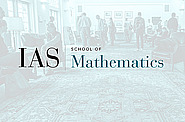Seminars Sorted by Series
Lecture Series on Some Aspects of the p-adic Local Langlands Correspondence for GL(2,Q_P)
Nov
11
2010
Nov
18
2010
Nov
25
2010
Dec
02
2010
Dec
08
2010
Lectures in Analysis and Geometry
Oct
06
2021
Lectures in Analysis and Geometry
Basic notions and user’s guide for fluid mechanics
2:00pm|Simonyi Hall 101 and Remote Access
Oct
13
2021
Lectures in Analysis and Geometry
The h-principle and weak solutions
2:00pm|Simonyi Hall 101 and Remote Access
Oct
20
2021
Lectures in Analysis and Geometry
Overview of the h-principle
2:00pm|Simonyi Hall 101 and Remote Access
Oct
27
2021
Lectures in Analysis and Geometry
The h-principle in fluid mechanics
2:00pm|Simonyi Hall 101 and Remote Access
Nov
03
2021
Nov
10
2021
Lectures in Analysis and Geometry
h-principle in symplectic topology
2:00pm|Simonyi Hall 101 and Remote Access
Nov
17
2021
Lectures in Analysis and Geometry
Stationary solutions of the Euler equations and Reeb vector fields
2:00pm|Simonyi Hall 101 and Remote Access
Dec
01
2021
Lectures in Analysis and Geometry
Rigidity and flexibility of isometric embeddings in $C^{1,\alpha}$ I
2:00pm|Simonyi Hall 101 and Remote Access
Dec
08
2021
Lectures in Analysis and Geometry
Rigidity and flexibility of isometric embeddings in C^{1,\alpha} II
2:00pm|Simonyi Hall 101 and Remote Access
Dec
15
2021
Lectures in Analysis and Geometry
The Ruelle invariant and convexity II
2:00pm|Simonyi Hall 101 and Remote Access
Jan
19
2022
Lectures in Analysis and Geometry
Informal meeting to discuss the topics
2:00pm|Simonyi Hall 101 and Remote Access
Lectures on Homological Mirror Symmetry
Lens of Computation on the Sciences
Nov
22
2014
Lens of Computation on the Sciences
The Computational Universe
Leslie Valiant
10:00am|Simonyi Hall 101
Nov
22
2014
Lens of Computation on the Sciences
Theoretical Computer Science and Economics
Tim Roughgarden
2:00pm|Simonyi Hall 101
Nov
22
2014
Lens of Computation on the Sciences
Computational Phenomena in Social Interaction
Jon Kleinberg
4:00pm|Simonyi Hall 101
Nov
22
2014
Library book event: Piero della Francesca (c. 1410-1492), Painter/Mathematician: a Gift
Mar
29
2018
Library book event: Piero della Francesca (c. 1410-1492), Painter/Mathematician: a Gift
4:00pm|White-Levy Room
Lie Groups, Representations and Discrete Mathematics
Oct
11
2005
Lie Groups, Representations and Discrete Mathematics
From Ramanujan Graphs to Ramanujan Complexes
Alex Lubotzky
2:00pm|S-101
Oct
21
2005
Lie Groups, Representations and Discrete Mathematics
Combinatorics of Simplicial Complexes
2:30pm|S-101
Nov
01
2005
Lie Groups, Representations and Discrete Mathematics
Buildings and the Spectra of their Laplacians
2:00pm|S-101
Nov
08
2005
Nov
22
2005
Lie Groups, Representations and Discrete Mathematics
The Comparison Between Kac-Moody and Arithmetic Groups
Bertrand Remy
2:00pm|S-101
Nov
30
2005
Lie Groups, Representations and Discrete Mathematics
Uniform Kazhdan Groups
Denis Osin
10:00am|S-101
Dec
06
2005
Dec
13
2005
Lie Groups, Representations and Discrete Mathematics
Hanoi Tower Groups, their Spectra and Growth of Diameters of Schreier Graphs
Rostislav Grigorchuk
2:00pm|S-101
Dec
20
2005
Lie Groups, Representations and Discrete Mathematics
Normal Subgroups of the Multiplicative Group of a Finite Dimensional Division Algebra, and Valuations
2:00pm|S-101
Jan
17
2006
Lie Groups, Representations and Discrete Mathematics
Linear Representations and Arithmeticity of Lattices in Products of Trees
2:00pm|S-101
Jan
24
2006
Lie Groups, Representations and Discrete Mathematics
The Classification of Finite Simple Groups: Aspects of the Second Generation Proof
Inna Korchagina
2:00pm|S-101
Jan
31
2006
Lie Groups, Representations and Discrete Mathematics
Paley Graphs and the Combinatorial Topology of the Bruhat Decomposition
Ron Livnè
2:00pm|S-101
Feb
14
2006
Lie Groups, Representations and Discrete Mathematics
Generalized Harmonic Maps Superridity and Uniformly Convex Metric Spaces
Tsachik Gelander
2:00pm|S-101
Feb
21
2006
Lie Groups, Representations and Discrete Mathematics
Lattices of Minimum Covolume in Classical Chevalley Groups over $\mathbb F_q((t))$
Alireza Salehi-Golsefidy
2:00pm|S-101
Feb
28
2006
Lie Groups, Representations and Discrete Mathematics
A Canonical Form for Automorphisms of Totally Disconnected Locally Compact Groups
George Willis
2:00pm|S-101

